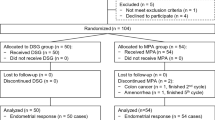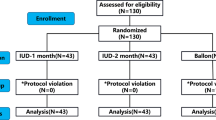Abstract
Purpose: The objective was to evaluate the effect of aspirinon infertile women with thin endometrium.
Methods: Patients who had thin endometrium (≤ 8 mm)and intrauterine insemination were divided into the aspirinand nonaspirin groups. Endometrial pattern (trilaminar andnontrilaminar) and thickness, the pulsatility index (PI) andresistance index (RI) of the uterine artery, spiral artery, andovarian dominant follicles, and pregnancy rates of bothgroups were measured.
Results: A total of 114 and 122 women were included inthe aspirin and nonaspirin groups, respectively. There weresignificantly higher percentages of trilaminar endometrium(46.5% vs. 26.2%) and pregnancy rate (18.4% vs. 9.0%)after aspirin therapy. There was nonsignificant differencein the endometrial thickness, and PI/RI values of the uterineartery, spiral artery, and ovarian dominant follicle betweenboth groups.
Conclusions: Higher pregnancy rate and better endometrialpattern were achieved in patients with thin endometriumafter aspirin administration. Aspirin therapy could notsignificantly increase the endometrial thickness and theresistance of uterine and ovarian flow.
Similar content being viewed by others
REFERENCES
Abdalla HI, Brooks AA, Johnson MR, Kirkland A, Thomas A, Studd JWW: Endometrial thickness: A predictor of implantation in ovum recipients? Hum Reprod 1994;9:363–365
Weckstein LN, Jacobson A, Galen D, Hampton K, Hammel J: Low-dose aspirin for oocyte donation recipients with a thin endometrium: Prospective, randomized study. Fertil Steril 1997; 68:927–930
Steer CV, Tan SL, Dillon D, Mason BA, Campbell S: Vaginal color Doppler assessment of uterine artery impedance correlates with immunohistochemical markers of endometrial receptivity required for the implantation of an embryo. Fertil Steril 1995; 63:101–108
Kuo HC, Hsu CC, Wang ST, Huang KE: Aspirin improves uterine blood flow in the peri-implantation period. J Formos Med Assoc 1997;96:253–257
Wada I, Hsu CC, Williams G, Macnamee MC, Brinsden PR: The benefits of low-dose aspirin therapy in women with impaired uterine perfusion during assisted conception. Hum Reprod 1994; 9:1954–1957
Shapiro H, Cowell C, Casper RF: The use of vaginal ultrasound for monitoring endometrial preparation in a donor oocyte program. Fertil Steril 1993;59:1055–1058
Testart J, Gauthier A: The action of anti-inflammatory drugs on the fertility of female rats with intrauterine contraceptive devices. J Reprod Fertil 1991;63:257–261
Weckstein LN, Jacobson A, Galen D, Hampton K, Hammel J: Low-dose aspirin for oocyte donation recipients with a thin endometrium: Prospective, randomized study. Fertil Steril 1997; 68:927–930
Check JH, Dietterich C, Lurie D, Nazari A, Chuong J:A matched study to determine whether low-dose aspirin without heparin improves pregnancy rates following frozen embryo transfer and/ or affects endometrial sonographic parameters. J Assist Reprod Genet 1998;15:579–582
Author information
Authors and Affiliations
Rights and permissions
About this article
Cite this article
Hsieh, YY., Tsai, HD., Chang, CC. et al. Gynecology: Low-Dose Aspirin for Infertile Women with Thin Endometrium Receiving Intraeuterine Insemination: A Prospective, Randomized Study. J Assist Reprod Genet 17, 174–177 (2000). https://doi.org/10.1023/A:1009474307376
Issue Date:
DOI: https://doi.org/10.1023/A:1009474307376




